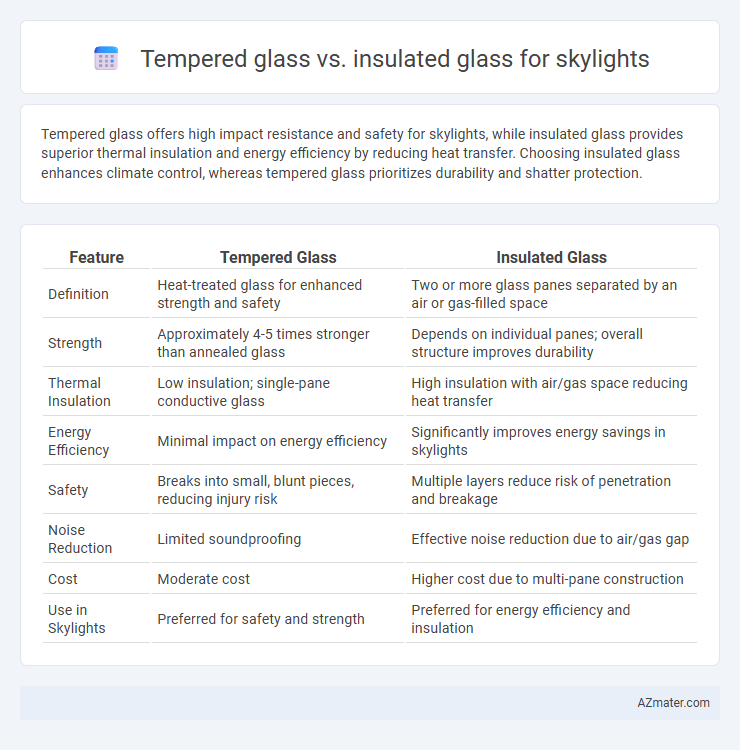Tempered glass offers high impact resistance and safety for skylights, while insulated glass provides superior thermal insulation and energy efficiency by reducing heat transfer. Choosing insulated glass enhances climate control, whereas tempered glass prioritizes durability and shatter protection.
Table of Comparison
| Feature | Tempered Glass | Insulated Glass |
|---|---|---|
| Definition | Heat-treated glass for enhanced strength and safety | Two or more glass panes separated by an air or gas-filled space |
| Strength | Approximately 4-5 times stronger than annealed glass | Depends on individual panes; overall structure improves durability |
| Thermal Insulation | Low insulation; single-pane conductive glass | High insulation with air/gas space reducing heat transfer |
| Energy Efficiency | Minimal impact on energy efficiency | Significantly improves energy savings in skylights |
| Safety | Breaks into small, blunt pieces, reducing injury risk | Multiple layers reduce risk of penetration and breakage |
| Noise Reduction | Limited soundproofing | Effective noise reduction due to air/gas gap |
| Cost | Moderate cost | Higher cost due to multi-pane construction |
| Use in Skylights | Preferred for safety and strength | Preferred for energy efficiency and insulation |
Introduction to Skylight Glass Options
Tempered glass and insulated glass are the two primary skylight glass options, each offering distinct advantages for durability and energy efficiency. Tempered glass is heat-strengthened to resist impact and thermal stress, making it ideal for safety and longevity. Insulated glass consists of multiple panes separated by a spacer, enhancing thermal insulation and reducing energy loss in skylight installations.
What is Tempered Glass?
Tempered glass is a safety glass processed by controlled thermal or chemical treatments to increase its strength compared to normal glass, making it ideal for skylights exposed to harsh weather conditions. It resists impacts, thermal stress, and shattering, breaking into small, blunt pieces rather than sharp shards, which enhances safety. This durability and safety standard make tempered glass a preferred choice for skylights in both residential and commercial buildings.
What is Insulated Glass?
Insulated glass for skylights consists of two or more glass panes separated by a sealed air or gas-filled space, enhancing thermal insulation and reducing heat transfer. This design improves energy efficiency by minimizing condensation and maintaining indoor temperature stability. Compared to tempered glass, which is primarily strengthened for impact resistance, insulated glass prioritizes thermal performance and comfort in skylight applications.
Comparative Strength and Durability
Tempered glass offers exceptional strength through a thermal tempering process, increasing its resistance to impact and thermal stress, making it less prone to breakage in skylights exposed to harsh weather. Insulated glass, composed of two glass panes separated by an air or gas-filled space, provides enhanced thermal insulation and reduces condensation but is more susceptible to seal failure over time. While tempered glass excels in durability against physical impacts, insulated glass optimizes energy efficiency and long-term climate control in skylight applications.
Energy Efficiency and Thermal Performance
Tempered glass and insulated glass differ significantly in energy efficiency and thermal performance for skylights, with insulated glass offering superior insulation due to its double or triple-pane construction filled with inert gas, reducing heat transfer and improving energy savings. Tempered glass provides enhanced strength and safety but lacks the thermal barrier properties of insulated glass, resulting in higher heat gain or loss. For optimal energy efficiency, insulated glass skylights minimize HVAC load by maintaining stable indoor temperatures, making them a preferred choice in climates with extreme temperatures.
Safety and Security Considerations
Tempered glass offers enhanced safety for skylights by shattering into small, blunt pieces upon impact, reducing injury risk during breakage. Insulated glass, often composed of two or more glass panes with a sealed air space, provides superior security by making forced entry more difficult due to its increased thickness and structural complexity. Choosing insulated glass with tempered outer panes combines impact resistance and thermal efficiency, maximizing both safety and security for skylight installations.
Noise Reduction Capabilities
Tempered glass and insulated glass both offer varying levels of noise reduction for skylights, with insulated glass generally providing superior sound insulation due to its dual-pane construction and air or gas-filled space that dampens sound waves. Tempered glass, while stronger and more impact-resistant, lacks the additional layers and air gaps that significantly reduce external noise transmission. Selecting insulated glass for skylights enhances acoustic comfort by minimizing external noise such as traffic and weather sounds more effectively than tempered glass alone.
Cost Analysis: Tempered vs. Insulated Glass
Tempered glass for skylights typically costs less upfront due to its simpler manufacturing process and enhanced safety features, making it a budget-friendly option for smaller installations. Insulated glass, while more expensive initially due to its dual-pane construction and gas-filled space for improved thermal performance, offers significant energy savings and reduced HVAC costs over time. Evaluating long-term benefits, insulated glass provides better cost efficiency by minimizing heat transfer and lowering utility bills, which can offset the higher initial investment compared to single-pane tempered glass.
Best Applications for Each Glass Type
Tempered glass is ideal for skylights in areas requiring high impact resistance and safety, such as commercial buildings and homes in regions prone to storms or severe weather. Insulated glass excels in energy efficiency, making it the best choice for skylights in climates with extreme temperatures, as it minimizes heat transfer and reduces energy costs. Combining both types in double-glazed units can optimize safety and thermal performance for skylights in diverse environmental conditions.
Choosing the Right Glass for Your Skylight
Tempered glass offers exceptional strength and safety for skylights, resisting impact and shattering into small, blunt pieces to minimize injury risks. Insulated glass provides superior thermal performance, reducing heat transfer and improving energy efficiency by utilizing two or more glass panes separated by an air or gas-filled space. Selecting the right glass depends on balancing safety requirements with energy efficiency needs, where tempered glass suits high-impact areas and insulated glass excels in climate control.

Infographic: Tempered glass vs Insulated glass for Skylight
 azmater.com
azmater.com